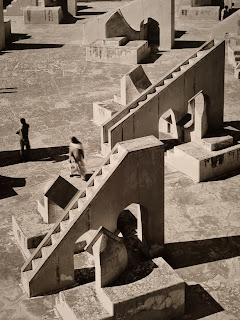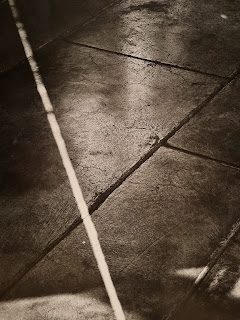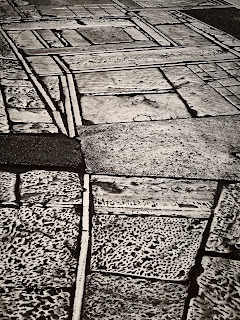"There is no such thing as an empty space or an empty time. There is always something to see, something to hear. In fact, try as we may to make a silence, we cannot" - John Cage
"The hands want to see, the eyes want to caress" - Goethe
Atelier Peter Zumthor - Bruder Klaus Field Chapel, Wachendorf, Germany (2007)
I'd never even heard of Helene Binet until the Royal Academy announced a retrospective, Light Lines, of the Swiss-French architectural photographer's work. On this basis I had assumed it would be poorly attended and I'd have the three upstairs rooms of the RA pretty much to myself.
Just as I like it. But, instead - and this could of course be simply down to people eager to get out now lockdown restrictions are all but entirely lifted, it was busy. There wasn't as much space as I'd have liked to take the work in and that's important because when it comes to appreciating, and discussing, the work of Helene Binet space is everything.
Atelier Peter Zumthor - Kolumba Museum, Cologne, Germany (2007)
Her work is as much about the gaps between the buildings as the buildings themselves and, even though her photographs are mostly monochrome, it is about the way the light infuses these buildings. Though there is more concrete and brickwork in her work than sky, or any nature really, the light of the sun is always a presence of sorts.
You can see it filling the skylights of Atelier Peter Zumthor's Bruder Klaus Field Chapel in Wachendorf or, elsewhere in Germany, more prismatically seeping through gaps in the walls of Daniel Libeskind's Jewish Museum in Berlin. Considering the history of the Jews in Berlin, it is hard to look at this photo and not be reminded of Leonard Cohen's Anthem - "there is a crack, a crack in everything. That's how the light gets in".
Daniel Libeskind - Jewish Museum, Berlin, Germany (1996/1999)
Daniel Libeskind - Jewish Museum, Berlin, Germany (1996/1999)
But Binet's work itself says nothing of human history and very little of humans except for their capacity to build and to create art. Specifically in the forms of both architecture and photography. Binet was born in 1959 in Sorengo in the south of Switzerland near the Italian border. She studied photography in Rome before working as a photographer, for two years, at the Grand Theatre de Geneva.
The architect Daniel Libeskind encouraged her in her ambition to move over to architectural photography and it was, as we can see, the making of her. She has an eye for how buildings both enhance and respond to their environment and, looking at these photos, it seems she has the patience and foresight to wait until the light is just right before taking her pictures.
Based now in London, and with a house on Osea Island on the Blackwater estuary in Essex (an area I must visit one day), I would like to think she'd be proud to see her work displayed at such an august institution as the RA. I certainly felt it was a pleasure and a privilege to be able to go and see them in my home city.
In a 1933 essay on aesthetics In Praise of Shadows, the Japanese author Jun'ichiro Tanizaki wrote "we find beauty not in the thing itself but in the patterns of shadows, the light and the darkness that one thing against another creates". It seems apt that that quote is affixed to the wall in this exhibition as it seems, along with the Goethe and John Cage quotes that top this piece, as good a description of Binet's style as anything.
Binet realised, early on, that photography could never capture the complexities and infinite possibilities of a building in a single image so, instead of trying to, she pared down her images to what she felt was the essence of each building. There are large sections of the buildings that have become her subjects that simply do not appear in the images she creates. But we know they are there. The space, the emptiness, the light, even the dust motes that float seemingly insignificantly in that light, let us know that which we cannot see.
Jantar Mantar Observatory, Jaipur, India (1734/2002)
They open us up to the possibilities of architecture while refusing to delve into specifics. That is for the architects, and structural engineers, themselves. Binet's work is not a how-to kit but simply a chance to marvel at the symbiotic nature of human creativity and the natural world.
A form of collaboration, if you will, that is echoed in the relationship that Binet has with the architects she works with and whose buildings she photographs. The Swiss architect Peter Zumthor, like Binet, works with, and manipulates, the play of light in his buildings. He utilises local, and natural, materials too. The Bruder Klaus Field Chapel was built by tightly binding one hundred and twelve tree trunks in a tapering frame before pouring concrete over them.
Zumthor, like Binet, is equally interested in modern building styles and techniques as she is ancient ones. After pouring the concrete, the timber frame was burnt away to leave a negative space and a charred, rugged interior that was odds with the smooth exterior walls. The light that pours through the open oculus exposes visitors to this in an attempt to make them feel more connected, spiritually one assumes, with nature.
Libeskind's Jewish Museum uses what we see described as "violent geometries, acute angles and seemingly impenetrable voids" to force visitors into an encounter with both the horrors and the absence of the Holocaust. It's a building I'd like to visit and an experience I'd expect to be an emotional one.
I'd also like to visit the remarkable Jantar Mantar Observatory in Jaipur. Built during the construction of the Pink City, Jaipur is Rajasthan's capital, as commanded by the ruler Jal Singh II, Jantar Mantar is a monumental series of astronomical structures which, to me, has something of Giorgio de Chirico's metaphysical paintings or even the peculiar architecture of Squid Game about it.
Le Corbusier - 'Canons de Lumiere', Couvent Sainte-Marie de la Tourette, Eveux, France (1961/2007)
Le Corbusier - Couvent Sainte-Marie de la Tourette, Eveux, France (1961/2002)
Le Corbusier - Couvent Sainte-Marie de la Tourette, Eveux, France (1961/2002)
When Le Corbusier visited Jantar Mantar he was inspired not just by how it was a space where light and darkness were used to understand the cosmos but also what it represented. An exalted attempt by humanity to reach out it into the world, the universe even, and try to come to terms with it. A rational attempt to understand things that sometimes seem so great we invent supernatural forces, and beings, to simplify them for us.
Binet, unsurprisingly, has history with Le Corbusier too. The Couvent Sainte-Marie de la Tourette in Eveux in eastern central France is one of his last ever completed buildings and it was one that Binet, quite unusually, even took a colour photo of.
Equally unusually, her photos of John Hejduk's Wall House in Groningen are taken from a little further back than usual. Far enough back to get (nearly) the whole of the building in. She's even allowed a little cloudy sky into the frame. Hejduk, like Binet and most others mentioned here, was interested in shape and spatial organisation and he also considered his architectural practice to foreground poetic and spiritual narratives.
John Hejduk - Wall House II, Groningen, Netherlands (2001)
John Hejduk - The House of the Suicide and The House of the Mother of the Suicide, Atlanta, United States (1990)
Which does sound a little pretentious and egotistical but that's what you get with these creative types. Imagine conceiving of a building, designing it, and then actually building the thing. It would go to your head. Well, it would mine.
Though I'd not previously heard of Hejduk (though his buildings do look great and what on earth is The House of the Suicide and The House of the Mother of the Suicide in Atlanta all about?) I was more familiar with the work of the British-Iraqi architect Zaha Hadid who died in 2016.
He work, much of it award winning, is considered to have reinvented the concept of expressionist architecture so it's only right and proper that Binet captured that feeling in her photos. Which she has. Hadid, famously, struggled to get anything actually built until 1993 when she was commissioned to build the Vitra Fire Station in Weil am Rhein which, if you were to simply attend the RA show and research no further, you'd be none the wiser as to what it looks like.
Zaha Hadid Architects - Riverside Museum, Glasgow, United Kingdom (2010/2011)
Zaha Hadid Architects - Heydar Aliyev Center, Baku, Azerbaijan (2010/2011)
It's all sharp angles, smooth surfaces, and elegant piloti. To look at Binet's image of it you'd think it would resemble a multi storey car park. This is a little frustrating but not necessarily deceitful or distracting. Again, Binet has captured the essence, rather than the whole, of Hadid's work.
She's done much the same for the Rosenthal Center for Contemporary Art in Cincinnati and Glasgow's Riverside Museum though for the Heydar Aliyev Center in Baku she's more generously given us a bit more than a glimpse of the building's ankles. It's curved, sloping, roof reminds me of the Serpentine Sackler Gallery in London and that's hardly surprising as that too is one of Hadid's creations.
Zaha Hadid Architects - Landesgartenschau/Landscape Formation One, Weil am Reich, Germany (1999)
Zaha Hadid Architects - Rosenthal Center for Contemporary Art, Cincinnata, United States (2003)
Hadid had remarked, of Binet's work, that it allowed her to see beauty in unexpected places and that, in turn, enabled obsverations that fed back into the design process. Creating an almost ouroboros style cycle of creativity between architect and photographer.
While many of Hadid's buildings use steel frames along with concrete, Binet is not against a bit of old school Brutalism for Brutalism's sake either. Gottfried Bohm, the first ever German architect to be awarded the Pritzker Prize, was commissioned, over half a decade ago, to build a series of concrete churches in Germany and the Church of the Resurrection of the Christ in Cologne is an eye catching work of concrete modernism that would surely stop any curious fan of architecture in their tracks should they stumble across it.
Gottfried Bohm - Church of the Resurrection of Christ, Cologne, Germany (1970/2020)
Sergio Musmeci - Ponte sul Basento, Potenza, Italy (1976/2015)
Of course, Binet has gone super close up and instead of showing us the majesty of the entire edifice she has captured the feel of it with some sharp and shadowy angles. She's done much the same for Sergio Musmeci's Ponte sul Basento in Potenza in the Basilicata region of Italy (that's in the south, the bit between the heel and the toes of the boot).
Musmeci, who died in 1981, was a civil engineer who built a large concrete bridge over the Basento river in Potenza that made use of curved concrete before computer aided design made that more common. He seems like something of an under appreciated pioneer and I must confess to always enjoying a bridge. There's something about them. They're practical and (often) beautiful and they connect both people and places.
Sergio Musmeci - Ponte sul Basento, Potenza, Italy (1976/2015)
Sigurd Lewerentz - St Mark's Church, Bjorkhagen, Stockholm, Sweden (1960/1989)
Yeah, bridges are okay. I'm all for bridges. Sigurd Lewerentz was another new name on me. A Swedish architect who died in 1975 he seems a stern and serious type (there are lofty claims made that his buildings questioned what it is to be human!) so it's perhaps appropriate he is most famous for building cemeteries and churches.
The RA has a Binet photo of his brick expressionist St Mark's Church in Stockholm and although it's a fine looking building it suffers (as does Dimitris Pikionis' somewhat unnecessary looking 'lanscaping' of the Acropolis in Athens) by being in a room alongside classical Chinese gardens, the work of Sverre Fehn and Jorn Utzon, and a couple of Hawksmoor churches. Always a favourite here at EIAPOE.
Lingering Garden, Classical Gardens of Suzhou, Suzhou, China (11c-19c/2018)
Humble Administrator's Garden, Classical Gardens of Suzhou, Suzhou, China (11c-19c/2018)
Humble Administrator's Garden, Classical Gardens of Suzhou, Suzhou, China (11c-19c/2018)
Jorn Utzon, Can Lis, Mallorca, Spain (1974/2019)
Utzon's Can Lis in Mallorca looks strangely idyllic, bathed in warm Iberian sun but yet made from the raw materials of industry. It's something of a departure from his earlier, and more famous, Sydney Opera House and Binet's photograph gives it a sense of deep and warm melancholy. Sverre Fehn's Hedmark Museum in Hamar, Norway (a museum that specialised in excavated artefacts from the region) is all mysterious curving concrete. With the curves leading to places which, no surprise, Binet refuses to show us.
The Classical Gardens of Suzhou in China's Jiangsu province are a UNESCO World Heritage Site and with names like the Lingering Garden and the Humble Administrator's Garden they evoke thoughts and images of China's history as well as its penchant for formalism. The gardens themselves are beautiful and full of wild, and seasonal, flowers and various other architectural whimsies and water features so Binet, as is her wont, focuses on the walls of the garden as if they are a tabula rasa in which she, and us - those that look at her photos, can feel free to create our own versions of the gardens.
As if building a prehistoric creature from the smallest amount of its preserved DNA. She's given us more to go on with the Hawksmoor - which is kind. Although many of us will be aware of what Hawksmoor's churches look like anyway. With St Mary Woolnoth, we're treated to a vertiginous wooden stairway but with Christ Church in Spitalfields we're given an alarmingly literal, for Binet, look at its majestic frontage and, perhaps more typically, a close up of the stone base and stem of one of its columns.
The chipped stonework, the play of shadow on the base of the column, the essence of a building captured in one small part of it, and the essence of an architect's work in one photo. It's Binet at her best which, as I learned from my visit to the RA, is very good indeed. She waited for the light, she got out her camera, and then she took photos of the inaction. But the inaction had within it histories and mysteries as deep as those buried in the very stones of these buildings themselves.
Nicholas Hawksmoor - Christ Church Spitalfields, London, United Kingdom (1729/2014)
Nicholas Hawksmoor - Christ Church Spitalfields, London, United Kingdom (1729/2014)
Nicholas Hawksmoor - St Mary Woolnoth, London, United Kingdom (1724/2014)
Sverre Fehn - Hedmark Museum, Hamar, Norway (1973/2009)
Sverre Fehn - Hedmark Museum, Hamar, Norway (1973/2009)
Atelier Peter Zumthor - Therme Vals (1996/2006)
Dimitris Pikionis - Landscaping of the Acropolis, Athens, Greece (1957/1989)
































No comments:
Post a Comment